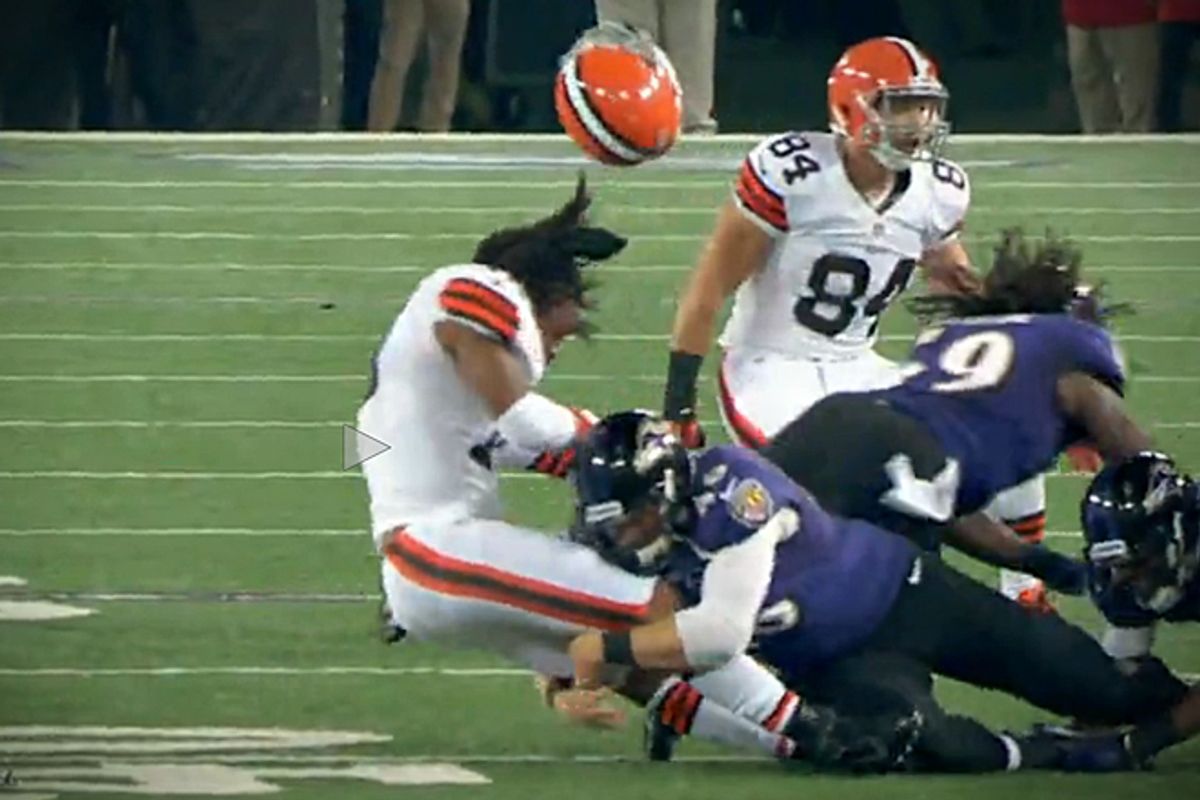 Each year about four million young athletes play football. It’s estimated that between 11 and 15 percent of those children get a concussion or mild traumatic brain injury (TBI). According to a 2011 study by the Centers for Disease Control and Prevention, there has been a 60 percent increase in all youth athletes treated for TBI in the past decade.
Each year about four million young athletes play football. It’s estimated that between 11 and 15 percent of those children get a concussion or mild traumatic brain injury (TBI). According to a 2011 study by the Centers for Disease Control and Prevention, there has been a 60 percent increase in all youth athletes treated for TBI in the past decade.
To combat growing unease among parents and observers, USA Football, the official football development partner of the NFL, created Heads Up Football, a program designed to help reduce head injuries in high-school football. The program has a nice website, videos, and a national advertising campaign. But the main component is making sure children are taught proper tackling technique.
The “better and safer tackle,” according to a USA Football video tutorial, is when an athlete begins from the proper stance, explodes from the hips, and leads with the chest—all with the intent of keeping the head up and out of the tackle.
In the NFL, where players are assumed to know how to tackle properly, 266 players suffered a concussion in 2011, according to Edgeworth Economics. It’s hard to know how accurate a gauge this number is with players underreporting injuries, but in week ten of the 2012 NFL season, three quarterbacks (remember there’s only 32 teams) were sidelined due to concussions.
Despite popular opinion and changing NFL rules, helmet-to-helmet collisions are not the only cause of concussions. “In fact, many concussions occur without direct contact to the head,” writes Dr. Robert Cantu, chief of Neurosurgery at Emerson Hospital, in his new book, Concussion and Our Kids. “They’re caused by rotational forces or accelerations—the head whips to one side and the brain shifts inside the skull.”
So will proper tackling initiatives fix youth football, or merely make parents think the NFL cares about fixing youth football?
“This public awareness fundamentally has nothing to do with what the NFL actually puts out as a product,” says Daniel Durbin, a professor at the Annenberg Institute of Sports, Media and Society at the University of Southern California. “It has to do with creating an image of them trying to help protect children, so that the parents of children will not keep their kids from playing football, and also so they will develop a new generation of football viewers.”
New studies appear routinely highlighting the dangers of repetitive on-field hits, and the NFL is facing the mounting legal challenges—to date there aremore than 3,962 player-plaintiffs in 182 cases—and the bad press that goes along with them.
In September of 2012, the NFL donated $30 million to the National Institute of Health. And, recently, it announced a new cartoon show on Nickelodeon. Some are reading this and the Heads Up Football program as part of a broader public relations strategy by the NFL.
Durbin says there is a long history of shifting blame away from the product or corporation by leaning on the American ideal of personal responsibility.
“The very best illustration is ‘drink responsibly’,” Durbin says. “We will sell you enough alcohol to make you a walking zombie, but it’s your responsibility to take the amount of alcohol that you can safely consume until you drop over and die.”
On the USA Football website, Dr. Patrick Kersey of St. Vincent Sports Medicine and Dr. Kevin Guskiewicz of the University of North Carolina Concussion Research Center endorse the idea that “developing fundamentals and learning proper mechanics dramatically reduces the chances for injury.”
However, USA Football hasn’t proven that proper tackling limits TBI yet. According to Scott Hallenbeck, executive director of USA Football, “What we believe is that the idea of the chest strike and having the head up-and-away is inherently safer, but I can’t prove it to you without evidence-based data.”
USA Football is studying the effects that their tackling method has on the rate of concussions.
Some medical professionals doubt that proper tackling will limit TBI in youth football, and Dr. Cantu wants to eliminate tackling in youth football below the age of 14 all together.
“Children are among the most vulnerable to injury because they have weak necks and immature musculature, and their brains are still developing,” writes Cantu.
While tackling is a major strategy for USA Football’s plan to fix the TBI problem, it’s only one part. They suggest a comprehensive solution that establishes an independent safety coach on the field, increases concussion awareness, and ensures parents are knowledgeable in regards to signs and symptoms of concussions. And Daniel Durbin is aware that the NFL, while trying to protect their brand, is also attempting to improve safety.
Yet, as The New York Times has reported, increased awareness and stricter rules are good for nothing if parents, coaches and referees ignore them.
This begs the question: can football ever be safe?
“There is no question that the game can be played safely and is safe,” Scott Hallenbeck says, “as long as it is taught properly and the players execute it properly. That is true for anything you do.”

Shares